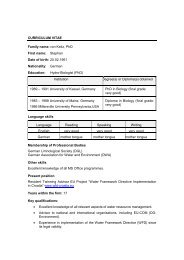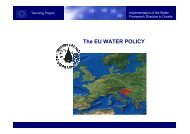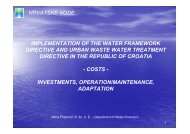BIODIVERSITY OF CROATIA
BIODIVERSITY OF CROATIA
BIODIVERSITY OF CROATIA
Create successful ePaper yourself
Turn your PDF publications into a flip-book with our unique Google optimized e-Paper software.
HABITATS<br />
F. COASTAL HABITATS<br />
This class consists of habitats above the high tide line that are<br />
under maritime influence. They are grouped into habitats of<br />
mud, sand, shingle and rocky shores. Among the most threatened<br />
are the rare mudflats of Northern Dalmatia, glassword<br />
swards and tall rush saltmarshes found at a few small localities,<br />
mixed delta habitats of the Neretva River as well as sand<br />
and shingle beaches.<br />
Intertidal mudflats are rare on the Croatian coast and are best<br />
preserved in the Neretva Delta area and Northern Dalmatia with<br />
nice sea inlets where mudflats border the glassword (Salicornia)<br />
swards and wet grassland vegetation. These habitats are important<br />
for wintering waders, sea ducks and other waterfowl.<br />
Sand and shingle beaches are represented on only 5.4% of<br />
Croatian coastline. These are extremely threatened habitats<br />
under the pressure of tourism, construction and waste disposal.<br />
Their specialised flora and fauna has all but disappeared at<br />
many sites. Some of the largest sand beaches are situated on<br />
The biggest part of the Croatian coast is formed of the rocky shore<br />
(photo: SINP)<br />
the island of Rab and in the Neretva Delta. Sand vegetation is<br />
still preserved at certain small localities like Saplunara beach on<br />
the island of Mljet.<br />
Coastal habitats forming parts of estuaries are in fact complex<br />
habitats classified under the class K in the NHC, together with<br />
lagoons. They consist of mixture of coastal and marine habitats.<br />
Both are threatened and rare areas on the Croatian coast,<br />
exposed to great pressures of development projects. Besides the<br />
Neretva Delta, the estuaries of the Krka and Zrmanja Rivers, which<br />
in fact submerged karst river canyons, are also interesting.<br />
Lagoons are isolated brackish waters connected to the sea by a<br />
narrow connection. Only a few such sites have been preserved on<br />
the Croatian coast, like the small lagoon in the Pantan wetland<br />
near Trogir and two large lagoons in the Neretva Delta.<br />
Rich stands of the glassword (Salicornia fruticosa) like this one on the<br />
Cres island are rare on the Croatian coast (photo: SINP)<br />
Protected sand beech Blace on the Mljet island with rare and critically<br />
endangered sea daffodil (Pancratium maritimum)<br />
(photo: A. Alegro)<br />
33









